Minnesota PUC Commissioner Says Electricity Costs Will Decrease: Not if Xcel’s Resource Plan is Approved
On Feb. 18, 2021, Commissioner John Tuma of the Minnesota Public Utilities Commission (PUC) called out grid operators in Texas for failing to plan for winter weather.
As reported by KTTC, Commissioner Tuma said, “As you noticed, we did pretty good. Minnesota planned well. Texas did not plan. Texas’ model was, ‘Build the cheapest thing, we don’t care.'”
It’s absolutely true that Texas grid operators were unprepared for a winter weather event of this scale and their lack of foresight led to rolling blackouts for much of Monday and Tuesday for millions of Texans. However, Mr. Tuma should understand that Minnesota is hardly on the right path when it comes to grid reliability because we are repeating many of the same mistakes made in the Lone Star State.
For example, Minnesota experienced its own challenges during the polar vortex of 2019, when wind and solar capacity suddenly fell off the grid due to negative 20-degree Fahrenheit temperatures and snow-covered panels. This resulted in Xcel Energy asking their natural gas customers to turn down their thermostats to conserve natural gas and avoid widespread outages. If we had been more dependent on natural gas for electricity generation, things would have gotten very bad, very quickly.
Thankfully for Minnesotans, we currently generate a larger percentage of our electricity from coal and nuclear power plants than they do in Texas. These coal and nuclear plants carried the day during the Polar Vortexes of 2019 and 2021. As Xcel explained, during the 2019 polar vortex, “firm dispatchable resources [fuel-based energy sources] were needed to fill the gap left by the forecast error and lack of wind.” [Emphasis added].
Minnesota may not be so fortunate in the future, as Xcel has proposed retiring its last remaining coal facilities by 2030, and renewable energy advocates in the state wish to see nuclear capacity off the grid, as well.
Gov. Tim Walz has already issued policy proposals seeking to make Minnesota’s electricity grid “100 percent clean energy” by 2040. However, “maintaining grid reliability at the 40% renewable penetration level becomes significantly more complex” based on a study by the Midcontinent Independent System Operator (MISO), which Minnesota is part of. Minnesota will have increasingly more trouble keeping the lights on for millions of Minnesotans if Governor Walz’s proposals become law.
Commissioner Tuma also used the opportunity to note several points about Minnesota’s grid that are incorrect need to be addressed.
“It has to have a partner”
Commissioner Tuma stated that “The winters [in Minnesota] have been basically renewables, solar and wind, matched with a partner. It has to have a partner. The sun doesn’t shine and the wind doesn’t blow everyday. It needs a good partner, and that partner is gas.”
However, his statement is only half-true. According to U.S. Energy Information Administration data, coal facilities in Minnesota are in fact the most significant “partner” for renewables during winter, as they out-performed combined-cycle natural gas facilities in November, January, and February in 2019. Mr. Tuma is correct is saying that the “sun doesn’t shine and the wind doesn’t blow everyday.” As such, wind and solar need backup energy sources to maintain reliability.
Fuel-based energy sources, on the other hand, don’t need renewables to maintain the reliability of Minnesota’s electricity grid. As a result, renewable energy sources, represent a premium expense compared to an electrical grid without any wind and solar on it. This is because sources like wind and solar only work when the weather cooperates, and this means they are inherently unable to reduce any reliable power plant capacity on the existing grid.
You can see this in the graph below, which shows that Xcel Energy is building more power plant capacity than ever before despite the fact that electricity use is lower today than it was in 2001.
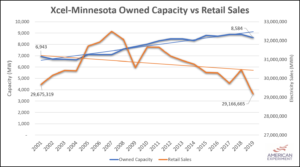
Even though electricity sales have been trending downward, Xcel has increased its capacity by roughly 1,600 MW, or 23.6 percent, due to significant renewable energy additions in recent years. This means that ratepayers are paying for renewable energy sources like wind and solar, and backup energy sources to remain on the grid in case the wind stops blowing and sun stops shining, like natural gas.
“We have already all the gas and wind plants we are going to need”
Mr. Tuma also stated that “We [Minnesotans] have already all the gas and wind plants we are going to need. So that will drive the cost down.”
This statement is alarming because it has no factual basis in reality. Xcel Energy recently submitted its plan for future power plants to the PUC, in addition to the one approved in 2015, which clearly states the company would add over 11,500 MW of wind, solar, and natural gas capacity from now to 2034, as the graph below shows. This would be more capacity than the amount Xcel currently owns.
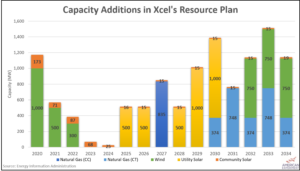
It is simply unbelievable to see a commissioner of the PUC say something so demonstrably false about a proposal brought forward by Minnesota’s largest investor-owned utility. These proposals clearly state the company would add thousands of megawatts of new wind and natural gas capacity to the grid.
However, if Mr. Tuma does believe there is no need for additional wind or gas capacity, then there is no good argument to sanction the approval of Xcel’s resource plan – which would cost Minnesota ratepayers over $57.1 billion through 2050.
That’s right – $57.1 billion, with a “B.”
This would cost each Xcel customer on average an additional $1,428 per year through 2050 and lead to significant increases in electricity rates, as the graph below shows.
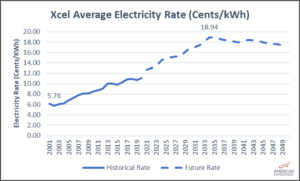
This leads to Commissioner Tuma’s last point.
Costs will go down
Mr. Tuma claimed that “I don’t think we are going to see any major [cost] increases. I really do think renewables provide Minnesota with a triple win. It’s cheap. It’s free energy right now. There are some infrastructure build down, there will be some early costs. In the long run though, it’s not going to cause our rates to go up. It hasn’t [yet], we are still below the national average.”
There’s a lot to unpack with this one.
To begin, wind and solar energy are anything but “free” and “cheap.”
First, Xcel Energy already wants to increase electricity prices by 20 percent, and this doesn’t even begin to pay for their latest $57 billion plan.
Second, according to data provided by the Federal Energy Regulatory Commission (FERC), existing wind and solar facilities in Minnesota cost $34.36 and $58.09 per megawatt-hour (MWh), respectively, in 2019. These costs do not include expenses for transmission lines to incorporate wind and solar facilities onto the grid, nor do they account for additional property taxes and utility profits that Minnesota ratepayers have been forced to pay for. Additionally, these costs are only achieved through large subsidies for renewable energy sources. As you can see by the graph below, new wind and solar energy sources that are likely not to receive this subsidy are far more expensive than existing fuel-based energy sources after including all additional expenses.
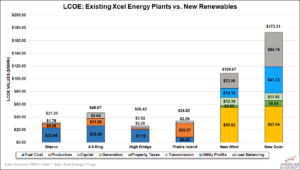
And while Commissioner Tuma is incorrect in calling wind and solar energy “cheap,” it’s interesting to hear him advocate for wind energy based on low costs after criticizing Texas grid operators for building “the cheapest” energy sources available. If building cheap energy sources led to the energy crisis in Texas, according to Mr. Tuma, then why would he be advocating for the same strategy in Minnesota?
Wind and Solar Facilities Don’t Last Very Long
Mr. Tuma claims “there will be some early costs” associated with building new wind and solar energy facilities, but it is inaccurate to say that in “the long run” costs will go down after paying off initial capital costs.
Wind and solar energy sources are unique in that they typically do not outlive their financial lifespans – meaning that as soon as initial capital investments are paid off, utility companies are forced to “repower” these facilities due to degrading electricity production. Xcel highlighted this by asking the PUC in 2020 to approve a $750 million expense to repower several wind farms before the end of their useful lives – in some cases only 5 years after wind turbines were built. Unfortunately, the PUC, including Commissioner Tuma, approved this measure.
What this means for states that go down the path of renewable energy is that electricity costs stay high because utilities are forced to perpetually spend billions of dollars to maintain existing infrastructure.
Contrarily, fuel-based energy sources, such as coal, natural gas, and nuclear facilities, often do outlive their initial capital expenses. This means that, eventually, costs will go down at these facilities, providing significant savings on electricity costs to millions of ratepayers in Minnesota.
The graph below showing inflation-adjusted residential electricity rates for Minnesota from 1990 to 2018 highlights this clearly.
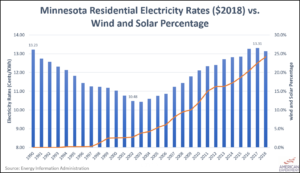
When Minnesota electricity providers utilized existing fuel-based energy sources through the end of their useful lives, residential electricity prices decreased from 1990 to 2004. When Minnesota started building more renewable energy sources (depicted by the orange line), residential electricity rates started increasing dramatically.
As you can see, Minnesota electricity rates have increased since the state started spending enormous sums of money on renewable energy additions.
Furthermore, as a result of significant expenditures to satisfy renewable energy mandates, Minnesota residential electricity rates have increased so dramatically that they are no longer below the national average (another point that Commissioner Tuma got wrong) as the graph from the Energy Information Administration (EIA) below shows.
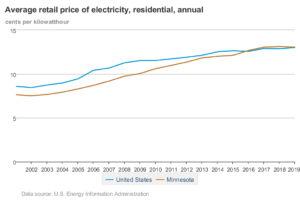
In fact, the only rate class in Minnesota that isn’t higher than the national average is commercial rates – which is only lower by 3.2 percent. Residential and industrial rates in Minnesota, however, have lost their competitive edge with the national average in recent years, which were once lower by 16.3 percent and 15.7 percent, respectively.
When you isolate Xcel, the largest electric utility in Minnesota, the picture becomes even worse.
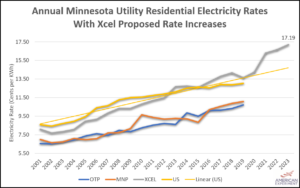
As you can see, Xcel residential electricity rates are the highest among the three utility companies in Minnesota – the other two being Otter Tail Power and Minnesota Power – and are significantly higher than the national average. The other two utility companies, for their part, have managed to stay far below the national average. This means that the primary reason Minnesota households now pay more for electricity than the national average is because of Xcel’s significant rate hikes in recent years – which, Xcel explains in its latest rate increase request, were required “to move us [Xcel] further toward our goal of providing carbon-free energy to our customers.”
Furthermore, as the graph below shows, Xcel industrial rates are also higher than the national average by nearly 18 percent. Interestingly, in 2002, industrial rates at Xcel were lower than the national average by nearly 18 percent, showcasing a complete flip-flop in terms of costs in recent years.
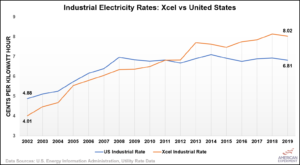
If the Minnesota PUC held Xcel accountable to keep electricity rates in each rate class 5 percent below the national average– a goal established in Minnesota state law – instead of approving significant rate increases in recent years to pay for unnecessary renewable energy projects, this wouldn’t have happened.
Since Commissioner Tuma expects that electricity rates are going to decrease in Minnesota, the only reasonable assumption is that he is planning to not approve Xcel’s most recent resource plan and save Minnesota ratepayers billions of dollars of additional expenses.
If Mr. Tuma and other commissioners on the Minnesota PUC do, in fact, approve Xcel’s resource plan, you can kiss any hope of decreasing electricity costs good-bye for decades to come.